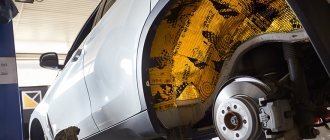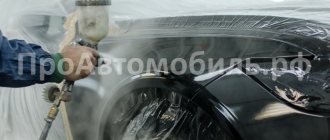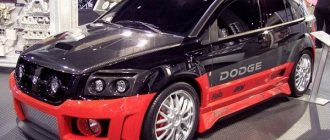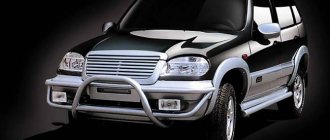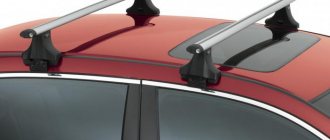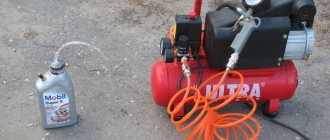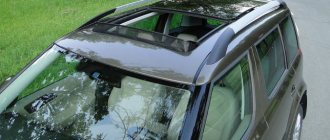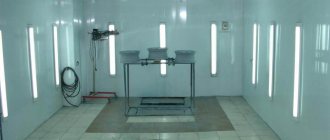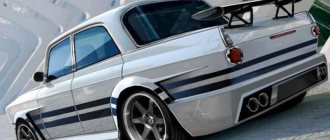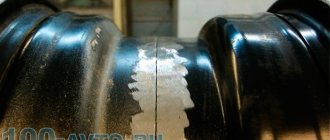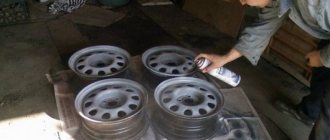In this article we will look at how to make car soundproofing with your own hands. Let's look at what sources of noise there are inside the car and what materials to install in different parts of the body.
Noise and vibrations in a car affect the overall comfort of the driver and passengers. Most cars already come equipped with a thin layer of damping coating in the doors and other panels, but this hardens over time due to numerous heating and cooling cycles and loses its properties. Even if the car has factory sound insulation, installing a good audio system requires additional vibration and noise insulation to obtain high-quality sound.
The content of the article:
- Sources of noise in a car
- Soundproofing a car, what materials are required
- What's wrong with bitumen materials for vibration isolation?
- DIY vibration isolation
- How to make sound insulation with your own hands
Sources of noise in a car
There are many different sources of noise, each producing a different frequency of sound.
Sound enters the cabin from all sides and is reflected many times inside the cabin.
There are two types of noise inside a car:
- The first is airborne. If you are stuck in a traffic jam in the city and lower the window, the noise level inside the cabin will increase. The change in noise level, in this case, will occur due to airborne noise. The window can be lowered just a little, but the noise level will increase significantly. Airborne noise is carried even through a small gap. Another type of airborne noise is that which is generated by reflection inside the cabin. If there are hard surfaces in the cabin, sounds will be reflected from these surfaces. Soft surfaces (such as velor upholstery and carpeting) will absorb noise.
- The second type of noise is the one that is transmitted through the body structure, this is structural noise (vibrations). For understanding, we can give a vivid example. If you put your ear to the rail, you will hear the movement of the train long before you hear it through the air. In this case, the sound is transmitted through the metal rail. In modern cars, structure-borne noise is more common than airborne noise. For this reason, materials that reduce body vibration are used as a basis.
More specifically, the following sources of noise inside the cabin can be named: wind noise, road noise from tires, engine, fans, transmission and exhaust system, noise when braking, the noise of raindrops on the roof.
Where does the sound end up? When a sound wave encounters a sound-absorbing material or barrier on its path, part of the sound energy is wasted, and the remaining part is reflected and continues to move in a different direction until it collides with another barrier. This process continues until the sound energy becomes inaudible and gradually dissipates.
Incorrect dismantling of the casing
At the very beginning of work, it is necessary to properly disassemble the door. For these purposes, it is best to use plastic spatulas, which will not damage the trim and paintwork of the door.
Do not use metal screwdrivers, especially with significant force. The main thing here is to do no harm.
The removed parts must be carefully placed in one place so as not to accidentally touch or mix them up later.
Dismantling should be carried out in the following sequence:
- You need to start with plastic parts: window regulator, armrest.
- Then carefully unscrew several mounting bolts.
- Place a plastic spatula under the bottom of the trim, pry it up and remove it. In this case, you do not need to go around the entire perimeter, but rather relieve tension in the area of several pistons. Under no circumstances should you “pick” the tool with force. This is likely to damage the door's paintwork, creating potential pockets of corrosion.
- Remove the casing as carefully as possible, trying not to damage the rods, the clamps of which are made of plastic. You can’t rush and tear off material.
- Place the removed casing in a safe place so as not to accidentally damage the thermal vinyl layer.
Do-it-yourself car soundproofing, what materials are required
There is no magic material that can effectively stop noise of different sound frequencies. The only way to effectively reduce the noise level in a car is to use several layers of different materials with different properties.
Each zone in the car has different noise loads from different noise sources. If all panels are sealed with the same material, the effect will be minimal and far from optimal.
Here are three main ways to stop the spread of sound:
- Stopping panel vibration by using vibration and noise insulation material. When sound travels through a solid object, it becomes vibration. Lightly hit the wine glass with a fork and you will hear a ringing sound. Now squeeze this wine glass with your fingers and the sound will stop abruptly - this is the effect of damping structural sound (vibration). Vibration and noise insulation materials reduce vibration and the sound that arises from it, just as in the example with the wine glass. Vibration-isolating material is most effective against low-frequency noise.
- Blocking sound using a dense sound barrier. Mass loaded vinyl is often used for this. This material is very dense and reduces the amount of noise that can travel through this material.
- Sound absorption. Soft, porous materials are used.
Let's take a closer look at the materials that are used for sound insulation and implement the above-described functions:
Butyl rubber vibration isolation material
- Vibro-noise-insulating (damping viscoelastic) material is made of bitumen or styrene-butadiene rubber (a more modern material). The idea is to add weight and rigidity to the sheet metal that makes up the body panel. By adding damping material to the panel, you change its resonant frequency and reduce the likelihood of vibration. If the surface is completely rigid, then adding damping material to it will not have any effect. As manufacturers say, modern vibration-isolating material dampens vibration and converts it into a small amount of heat, which is almost impossible to feel. It can also be installed between panels to reduce the amount of vibration between them when they are close together. Many of these materials have metal foil on them. It is designed to improve their heat resistance and heat reflection. This helps retain heat inside the cabin. This type of material does not require covering the entire surface to be functional. In most cases, 50% coverage is enough to eliminate vibration. These materials are ineffective as a barrier to stop sound from entering the vehicle interior.
Loaded vinyl (sound barrier)
- Soundproofing materials create a barrier to noise. The most commonly used sound barrier is so-called mass-loaded vinyl. It is dense but elastic. Vinyl has a very low resonant frequency, making it ideal for use as a sound barrier. This type of soundproofing blocks a significant amount of sound and is most effective against sound transmitted through the air, but is not useful for isolating the sounds of shock and vibration that are transmitted through the structure. This material, unlike vibration-proofing material, must be installed without gaps, on 90–100% of the area. Any gap will cause external noise to enter. The sound barrier must be installed overlapping and a special tape must be used to seal the joints. A 1% gap in any sound barrier will let in 30% of the sound, and a 5% gap will let in 90% of the noise. Loaded vinyl can be installed in the car wherever possible. It must be separated from the surface of the car. For this, a thin foam or fibrous material is used.
Noise-absorbing material
- Sound-absorbing materials are one of the elements of sound insulation. Most materials with sound-absorbing properties are designed to improve acoustics in confined spaces. Such materials reduce reverberation (multiple reflections of sound) and echo. Sound absorption plays a role in sound insulation, but should be used as a complement to vibration isolation and sound barriers. Soft materials such as polyurethane foam, felt, jute and others can be used to absorb sound. All these materials allow air to flow into the cellular structure, where the sound energy is dissipated. The more fibers in the path of sound, the better it is dissipated. Foam sound-absorbing material provides a wide spectrum of frequency absorption. It requires covering as much of the panel area as possible. Open-cell foam dampens sound better than closed-cell foam, but it can absorb water and rot and fall apart in wet areas. To be an effective sound absorber, any material must have a certain thickness.
- Sound separator (thin polyurethane foam with closed cells “anti-creaking”). Another type of noise is a rumble or squeak, which occurs when two or more vibrating panels periodically briefly contact each other. “Anti-creak” helps eliminate this noise.
- Hybrid materials. Some products on the market for soundproofing materials combine 2 or more materials with different properties. For example, there might be a combination of closed cell foam and heavy duty vinyl combined into one sheet.
For comprehensive vibration and noise insulation, a combination of vibration-isolating material with a layer of foam material and a layer of sound barrier is used.
Popular manufacturing companies
The stores offer many brands that differ in the quality of their products.
The best sound insulators are supplied by the following companies:
- STP is in first place in the ranking of recognizable brands. A large Russian manufacturer has a developed network of stores covering the entire country. Manufactured products undergo mandatory certification and quality control.
- SGM cannot be called popular, but the products produced by the company are widespread among car enthusiasts. People involved in professional installation of soundproofing give good reviews about the products of this brand. SGM noise insulation materials are characterized by a good price-quality ratio.
- Technical Group produces products that offer the best performance. This is explained by the constant introduction of new technologies and quality control of manufactured goods. Technical Group is developing more advanced soundproofing materials.
- Shumoff has received positive feedback from car tuning customers. Professionals consider Shumoff to be the best domestic manufacturer producing self-adhesive sheets. However, the fairly high cost of the product does not allow the company to get to the first line of the rating.
What's wrong with bitumen materials for vibration isolation?
Bitumen sheets reduce vibration well at normal temperatures. If the car is operated in an area where temperatures are too high or low, problems may arise. When it gets cold, it hardens and peels off. In the heat, bitumen sheets can melt and fall apart over time. Some bitumen sheets contain a small percentage of rubber in their composition to make them less susceptible to heat, but this is not enough on hot summer days when the body temperature rises, and bitumen sheets with the addition of rubber gradually break down even at lower temperatures. Butyl rubber sheets do not have this tendency.
It is believed that vibration-proofing materials work by adding mass to the metal of the panel and reducing its resonant frequency. This is true for bitumen sheets, but is not entirely true for butyl rubber based material (modern foil materials). They work thanks to many sequential actions of the material. It all depends on such a property of the material as viscoelasticity. This term describes something that can become deformed and then return to its original shape more slowly than it was deformed. Butyl rubber is viscoelastic, but bitumen is not. Butyl rubber material is able to dampen vibrations, turning them into a small amount of heat. In addition, bitumen sheets are much heavier than butyl rubber and, if used in large quantities, they significantly increase the weight of the machine. Thus, taking into account all the disadvantages, bitumen sheets are better than nothing, but worse than butyl rubber.
The inexpensive bitumen-based building materials that some people use can melt in the summer heat and create an unpleasant odor in the interior.
Forgot to mark
Before dismantling the casing, it is recommended to take a marker and outline the contours of the old casing, as well as mark the places where the clips will be installed.
If this is not done, then after seaming the surface you will need to pick out the holes. After this, the clips do not snap properly. You should not seal such places at all.
Create a template
Creating a template will prevent cutting irregularly shaped material. Since the car is mostly symmetrical, templates cut for one side will also be suitable for the opposite side. For the template, you can use cardboard or thick paper. You must first take approximate measurements of the area where the sound insulation will be glued. Cut the cardboard 10cm larger than the size of the area you will be soundproofing.
Next, align one edge of the template, glue it for convenience with masking tape or tape, then adjust the remaining edges of the template in place, taking into account the configuration of the panel.
DIY vibration isolation
Vibration-proofing materials are glued first as a base on which sound-proofing and sound-absorbing materials can be installed. You can only install vibration-proofing materials (which, in most cases, many people do), but the effect will not be complete. Installation of vibration and noise insulation material is required for most parts of the car body. Vibration dampening material, as an addition to an audio system installation, is designed to reduce or prevent rumble and vibration generated by low frequencies. The main purpose of vehicle vibration isolation is to obtain clean bass from the audio system.
Installing a full set of vibration isolation in a car will add an average of 25–40 kg of additional weight.
The thickness of the metal on the bottom is different from the thickness on the roof. Based on this, the thickness of the vibration insulation should be selected accordingly. Vibration isolation material can have different thicknesses (usually 1.6 mm, 2 mm, 2.6 mm and 4 mm). On the bottom of the body, the vibration insulation layer should be thicker, and on the roof there will be a fairly thin layer.
Vibration dampening material is most effective if it covers 50% (maximum 80%) of the panel area. Covering the surface 100% with this material is useless and will only add extra weight to the car. Installing the material on 20% of the area, in the middle of the panel, will give 80% of the improvements, eliminating most of the vibration and rumble. Gluing the material to the remaining 80% will only make a 20% difference.
Using multiple layers of vibration dampening material to reduce road noise (airborne) certainly has some effect on road noise reduction, as it adds significant mass to the sound path. But vibration-proofing material does not have a structure that would reflect sound. Instead of all these layers, it is better to use one layer as vibration insulation and an additional layer of material that specifically serves as a sound barrier.
To install vibration isolation yourself, you need to disassemble the car interior.
After removing the protective paper, the material becomes sticky and easily sticks to any surface. After gluing, you need to cut off the remains and cut out the necessary technological holes.
When applied, the material must be carefully pressed against the metal. Vibration-isolating material not tightly glued to the surface will not provide a vibration-isolation effect.
Modern materials do not require heating during the process of gluing and smoothing, however, if sound insulation is carried out in a cold room, then it is necessary to preheat the metal and material, or both. The material is very elastic and easily follows all the contours and shapes of the panel. Use a roller to smooth the sheets. Start leveling from the center and continue to the edges, rolling each panel outline. Even if the surface is flat, rolling with a roller will ensure good adhesion and full contact of the material with the panel, removing air bubbles.
Pasting with vibration insulation does not guarantee the complete absence of rumble. If everything is done correctly and efficiently, then vibrations and noise will remain at a minimum level.
Basic requirements for sound insulation
Before you begin the workflow, you need to familiarize yourself with the basic requirements. They include:
Availability of free space. It is recommended to carry out soundproofing of the fender liner, doors, and ceiling of the car with your own hands in a spacious room. This will provide unobstructed access to individual parts of the vehicle structure;
Set of tools. For dismantling, use a silicone roller, a sharp knife, a set of keys, screwdrivers, protective gloves and sharp scissors.
In addition, you need to purchase a special degreaser that will remove the sticky layer from the surface of the insulating material.When working with this composition, it is important to be especially careful. When in contact with air masses, they release harmful toxic compounds that can cause chemical poisoning.
To ensure a tight fit of the vibration-insulating sheets to the metal surface, it is necessary to use an industrial hair dryer. It will provide surface heating up to 25 degrees.
